Marketing Annotated Bibliography: Customer Satisfaction in Restaurants
VerifiedAdded on 2023/01/18
|6
|1452
|70
Annotated Bibliography
AI Summary
This annotated bibliography examines customer satisfaction within the context of Australian restaurants, drawing upon several key academic sources. The first source explores the psychological concepts of balance, congruity, and dissonance in shaping customer behavior and the role of marketing in measuring this impact, including the use of Likert scales and longitudinal studies. The second source investigates the influence of employee service behavior, both personal and functional aspects, on customer satisfaction, based on a survey of tourists in a Jordanian restaurant and suggesting recommendations for improving employee skills. The third source analyzes the impact of social media on customer satisfaction in business-to-business (B2B) sales, highlighting its role in facilitating interactions and understanding customer preferences through the use of structural equation modeling. Finally, the fourth source examines the effects of service quality, particularly in internet service provision, on customer behavior, utilizing a mixed-methods approach to assess how online services impact customer perceptions and purchase decisions, with a focus on network standards and the role of contracts in retaining customers.

Running head- MARKETING
Annotated bibliography on customer satisfaction- A case study of Australian restaurants
Name of the student
Name of the university
Author note
Annotated bibliography on customer satisfaction- A case study of Australian restaurants
Name of the student
Name of the university
Author note
Paraphrase This Document
Need a fresh take? Get an instant paraphrase of this document with our AI Paraphraser
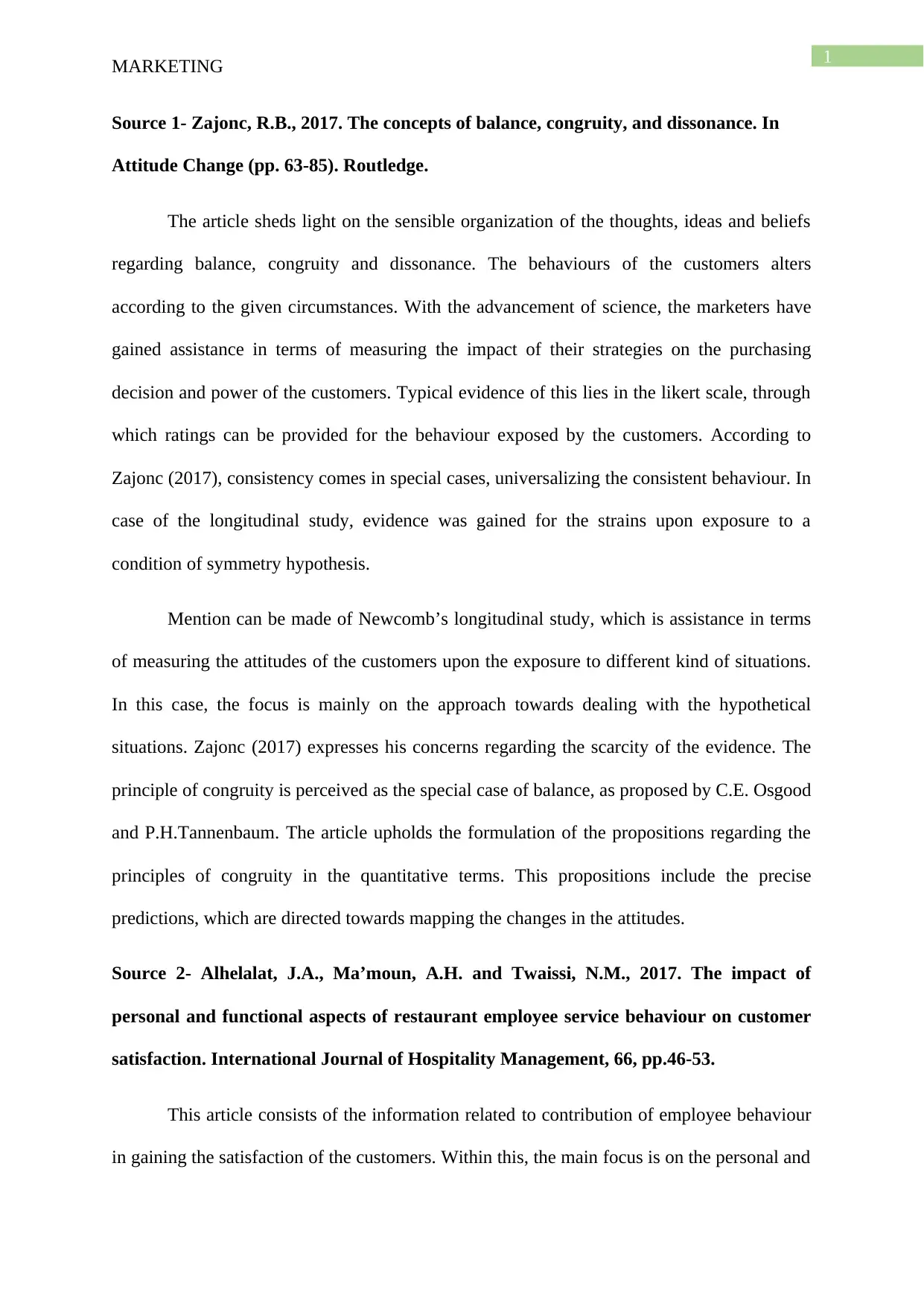
1
MARKETING
Source 1- Zajonc, R.B., 2017. The concepts of balance, congruity, and dissonance. In
Attitude Change (pp. 63-85). Routledge.
The article sheds light on the sensible organization of the thoughts, ideas and beliefs
regarding balance, congruity and dissonance. The behaviours of the customers alters
according to the given circumstances. With the advancement of science, the marketers have
gained assistance in terms of measuring the impact of their strategies on the purchasing
decision and power of the customers. Typical evidence of this lies in the likert scale, through
which ratings can be provided for the behaviour exposed by the customers. According to
Zajonc (2017), consistency comes in special cases, universalizing the consistent behaviour. In
case of the longitudinal study, evidence was gained for the strains upon exposure to a
condition of symmetry hypothesis.
Mention can be made of Newcomb’s longitudinal study, which is assistance in terms
of measuring the attitudes of the customers upon the exposure to different kind of situations.
In this case, the focus is mainly on the approach towards dealing with the hypothetical
situations. Zajonc (2017) expresses his concerns regarding the scarcity of the evidence. The
principle of congruity is perceived as the special case of balance, as proposed by C.E. Osgood
and P.H.Tannenbaum. The article upholds the formulation of the propositions regarding the
principles of congruity in the quantitative terms. This propositions include the precise
predictions, which are directed towards mapping the changes in the attitudes.
Source 2- Alhelalat, J.A., Ma’moun, A.H. and Twaissi, N.M., 2017. The impact of
personal and functional aspects of restaurant employee service behaviour on customer
satisfaction. International Journal of Hospitality Management, 66, pp.46-53.
This article consists of the information related to contribution of employee behaviour
in gaining the satisfaction of the customers. Within this, the main focus is on the personal and
MARKETING
Source 1- Zajonc, R.B., 2017. The concepts of balance, congruity, and dissonance. In
Attitude Change (pp. 63-85). Routledge.
The article sheds light on the sensible organization of the thoughts, ideas and beliefs
regarding balance, congruity and dissonance. The behaviours of the customers alters
according to the given circumstances. With the advancement of science, the marketers have
gained assistance in terms of measuring the impact of their strategies on the purchasing
decision and power of the customers. Typical evidence of this lies in the likert scale, through
which ratings can be provided for the behaviour exposed by the customers. According to
Zajonc (2017), consistency comes in special cases, universalizing the consistent behaviour. In
case of the longitudinal study, evidence was gained for the strains upon exposure to a
condition of symmetry hypothesis.
Mention can be made of Newcomb’s longitudinal study, which is assistance in terms
of measuring the attitudes of the customers upon the exposure to different kind of situations.
In this case, the focus is mainly on the approach towards dealing with the hypothetical
situations. Zajonc (2017) expresses his concerns regarding the scarcity of the evidence. The
principle of congruity is perceived as the special case of balance, as proposed by C.E. Osgood
and P.H.Tannenbaum. The article upholds the formulation of the propositions regarding the
principles of congruity in the quantitative terms. This propositions include the precise
predictions, which are directed towards mapping the changes in the attitudes.
Source 2- Alhelalat, J.A., Ma’moun, A.H. and Twaissi, N.M., 2017. The impact of
personal and functional aspects of restaurant employee service behaviour on customer
satisfaction. International Journal of Hospitality Management, 66, pp.46-53.
This article consists of the information related to contribution of employee behaviour
in gaining the satisfaction of the customers. Within this, the main focus is on the personal and
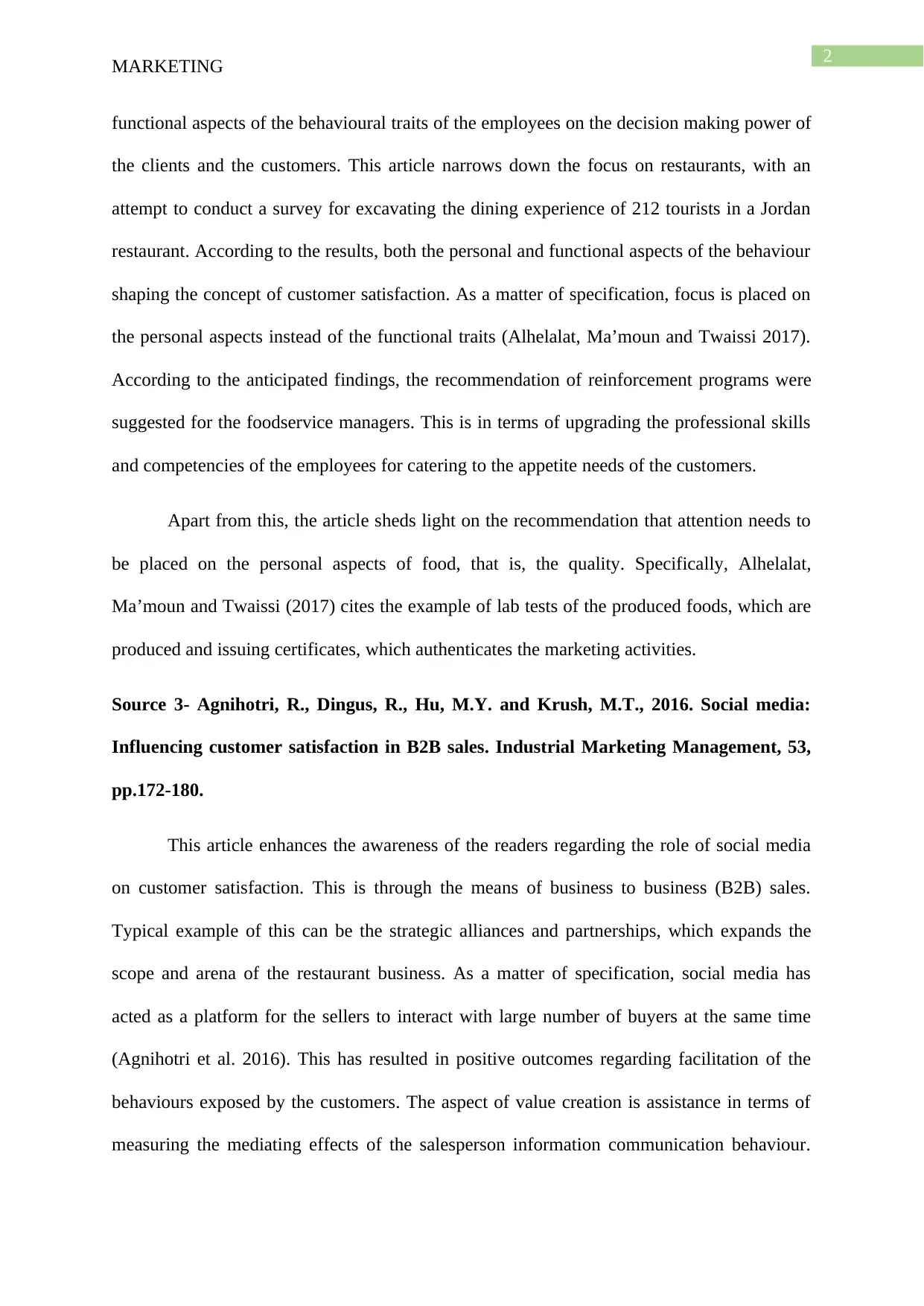
2
MARKETING
functional aspects of the behavioural traits of the employees on the decision making power of
the clients and the customers. This article narrows down the focus on restaurants, with an
attempt to conduct a survey for excavating the dining experience of 212 tourists in a Jordan
restaurant. According to the results, both the personal and functional aspects of the behaviour
shaping the concept of customer satisfaction. As a matter of specification, focus is placed on
the personal aspects instead of the functional traits (Alhelalat, Ma’moun and Twaissi 2017).
According to the anticipated findings, the recommendation of reinforcement programs were
suggested for the foodservice managers. This is in terms of upgrading the professional skills
and competencies of the employees for catering to the appetite needs of the customers.
Apart from this, the article sheds light on the recommendation that attention needs to
be placed on the personal aspects of food, that is, the quality. Specifically, Alhelalat,
Ma’moun and Twaissi (2017) cites the example of lab tests of the produced foods, which are
produced and issuing certificates, which authenticates the marketing activities.
Source 3- Agnihotri, R., Dingus, R., Hu, M.Y. and Krush, M.T., 2016. Social media:
Influencing customer satisfaction in B2B sales. Industrial Marketing Management, 53,
pp.172-180.
This article enhances the awareness of the readers regarding the role of social media
on customer satisfaction. This is through the means of business to business (B2B) sales.
Typical example of this can be the strategic alliances and partnerships, which expands the
scope and arena of the restaurant business. As a matter of specification, social media has
acted as a platform for the sellers to interact with large number of buyers at the same time
(Agnihotri et al. 2016). This has resulted in positive outcomes regarding facilitation of the
behaviours exposed by the customers. The aspect of value creation is assistance in terms of
measuring the mediating effects of the salesperson information communication behaviour.
MARKETING
functional aspects of the behavioural traits of the employees on the decision making power of
the clients and the customers. This article narrows down the focus on restaurants, with an
attempt to conduct a survey for excavating the dining experience of 212 tourists in a Jordan
restaurant. According to the results, both the personal and functional aspects of the behaviour
shaping the concept of customer satisfaction. As a matter of specification, focus is placed on
the personal aspects instead of the functional traits (Alhelalat, Ma’moun and Twaissi 2017).
According to the anticipated findings, the recommendation of reinforcement programs were
suggested for the foodservice managers. This is in terms of upgrading the professional skills
and competencies of the employees for catering to the appetite needs of the customers.
Apart from this, the article sheds light on the recommendation that attention needs to
be placed on the personal aspects of food, that is, the quality. Specifically, Alhelalat,
Ma’moun and Twaissi (2017) cites the example of lab tests of the produced foods, which are
produced and issuing certificates, which authenticates the marketing activities.
Source 3- Agnihotri, R., Dingus, R., Hu, M.Y. and Krush, M.T., 2016. Social media:
Influencing customer satisfaction in B2B sales. Industrial Marketing Management, 53,
pp.172-180.
This article enhances the awareness of the readers regarding the role of social media
on customer satisfaction. This is through the means of business to business (B2B) sales.
Typical example of this can be the strategic alliances and partnerships, which expands the
scope and arena of the restaurant business. As a matter of specification, social media has
acted as a platform for the sellers to interact with large number of buyers at the same time
(Agnihotri et al. 2016). This has resulted in positive outcomes regarding facilitation of the
behaviours exposed by the customers. The aspect of value creation is assistance in terms of
measuring the mediating effects of the salesperson information communication behaviour.
⊘ This is a preview!⊘
Do you want full access?
Subscribe today to unlock all pages.

Trusted by 1+ million students worldwide
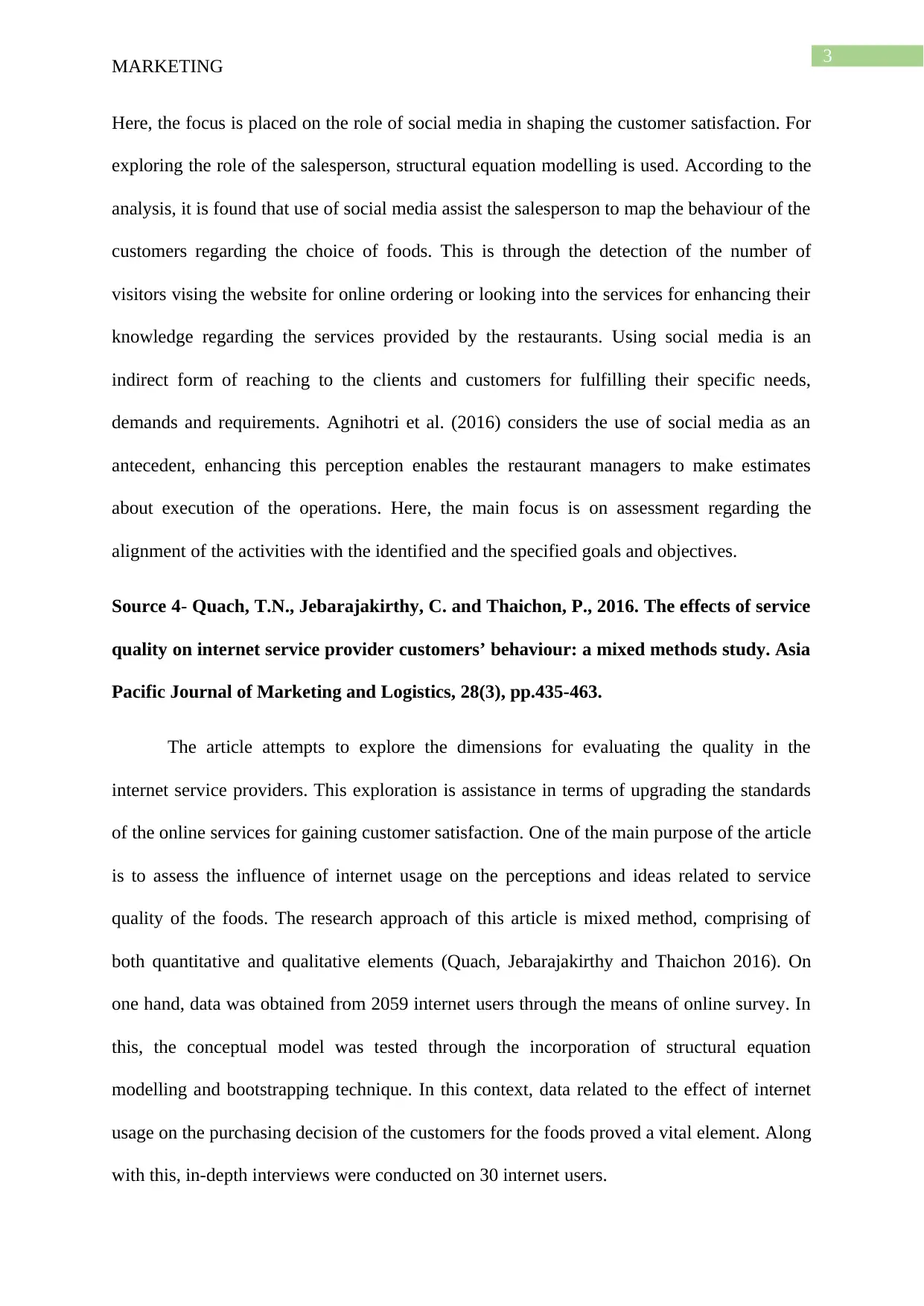
3
MARKETING
Here, the focus is placed on the role of social media in shaping the customer satisfaction. For
exploring the role of the salesperson, structural equation modelling is used. According to the
analysis, it is found that use of social media assist the salesperson to map the behaviour of the
customers regarding the choice of foods. This is through the detection of the number of
visitors vising the website for online ordering or looking into the services for enhancing their
knowledge regarding the services provided by the restaurants. Using social media is an
indirect form of reaching to the clients and customers for fulfilling their specific needs,
demands and requirements. Agnihotri et al. (2016) considers the use of social media as an
antecedent, enhancing this perception enables the restaurant managers to make estimates
about execution of the operations. Here, the main focus is on assessment regarding the
alignment of the activities with the identified and the specified goals and objectives.
Source 4- Quach, T.N., Jebarajakirthy, C. and Thaichon, P., 2016. The effects of service
quality on internet service provider customers’ behaviour: a mixed methods study. Asia
Pacific Journal of Marketing and Logistics, 28(3), pp.435-463.
The article attempts to explore the dimensions for evaluating the quality in the
internet service providers. This exploration is assistance in terms of upgrading the standards
of the online services for gaining customer satisfaction. One of the main purpose of the article
is to assess the influence of internet usage on the perceptions and ideas related to service
quality of the foods. The research approach of this article is mixed method, comprising of
both quantitative and qualitative elements (Quach, Jebarajakirthy and Thaichon 2016). On
one hand, data was obtained from 2059 internet users through the means of online survey. In
this, the conceptual model was tested through the incorporation of structural equation
modelling and bootstrapping technique. In this context, data related to the effect of internet
usage on the purchasing decision of the customers for the foods proved a vital element. Along
with this, in-depth interviews were conducted on 30 internet users.
MARKETING
Here, the focus is placed on the role of social media in shaping the customer satisfaction. For
exploring the role of the salesperson, structural equation modelling is used. According to the
analysis, it is found that use of social media assist the salesperson to map the behaviour of the
customers regarding the choice of foods. This is through the detection of the number of
visitors vising the website for online ordering or looking into the services for enhancing their
knowledge regarding the services provided by the restaurants. Using social media is an
indirect form of reaching to the clients and customers for fulfilling their specific needs,
demands and requirements. Agnihotri et al. (2016) considers the use of social media as an
antecedent, enhancing this perception enables the restaurant managers to make estimates
about execution of the operations. Here, the main focus is on assessment regarding the
alignment of the activities with the identified and the specified goals and objectives.
Source 4- Quach, T.N., Jebarajakirthy, C. and Thaichon, P., 2016. The effects of service
quality on internet service provider customers’ behaviour: a mixed methods study. Asia
Pacific Journal of Marketing and Logistics, 28(3), pp.435-463.
The article attempts to explore the dimensions for evaluating the quality in the
internet service providers. This exploration is assistance in terms of upgrading the standards
of the online services for gaining customer satisfaction. One of the main purpose of the article
is to assess the influence of internet usage on the perceptions and ideas related to service
quality of the foods. The research approach of this article is mixed method, comprising of
both quantitative and qualitative elements (Quach, Jebarajakirthy and Thaichon 2016). On
one hand, data was obtained from 2059 internet users through the means of online survey. In
this, the conceptual model was tested through the incorporation of structural equation
modelling and bootstrapping technique. In this context, data related to the effect of internet
usage on the purchasing decision of the customers for the foods proved a vital element. Along
with this, in-depth interviews were conducted on 30 internet users.
Paraphrase This Document
Need a fresh take? Get an instant paraphrase of this document with our AI Paraphraser
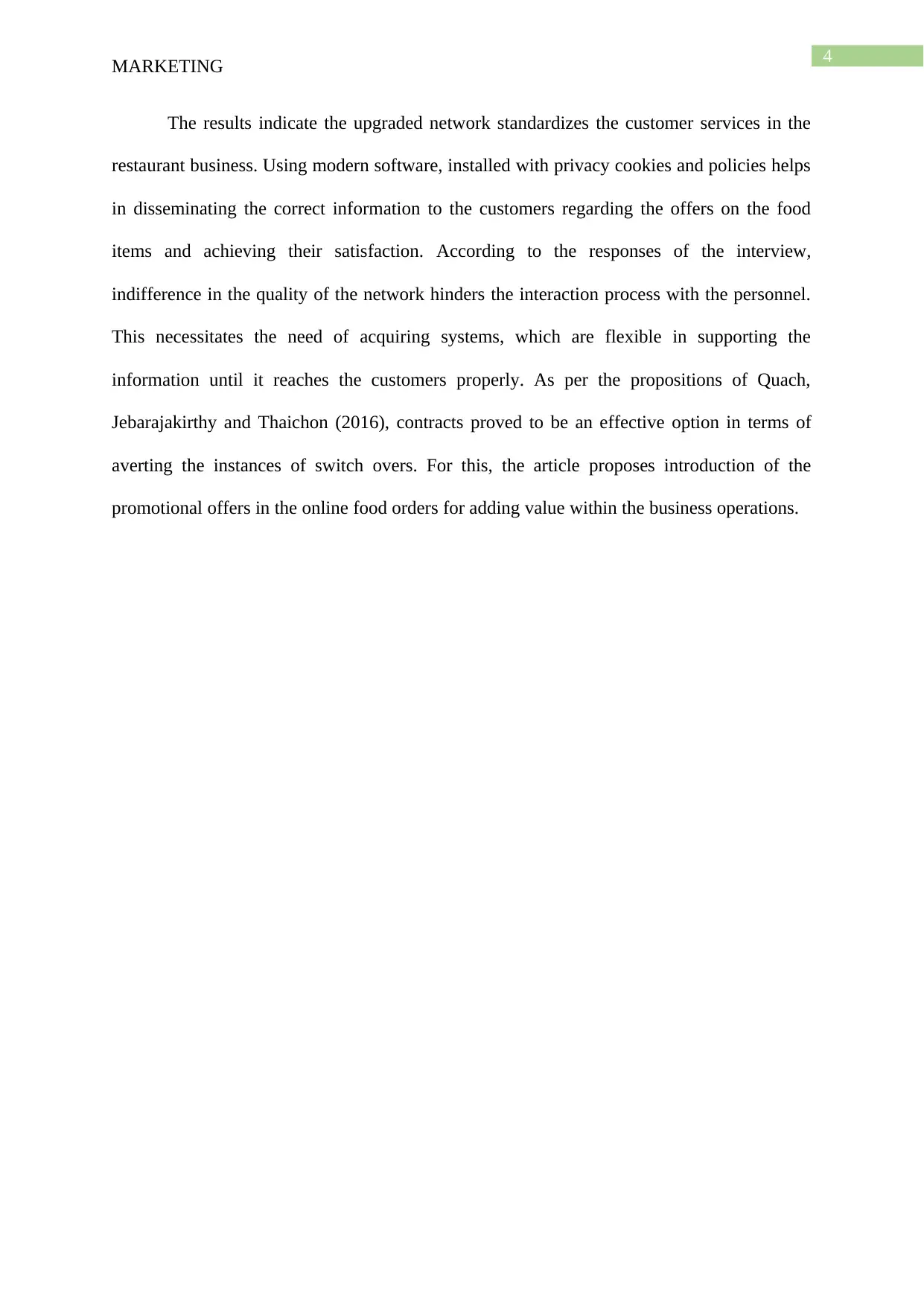
4
MARKETING
The results indicate the upgraded network standardizes the customer services in the
restaurant business. Using modern software, installed with privacy cookies and policies helps
in disseminating the correct information to the customers regarding the offers on the food
items and achieving their satisfaction. According to the responses of the interview,
indifference in the quality of the network hinders the interaction process with the personnel.
This necessitates the need of acquiring systems, which are flexible in supporting the
information until it reaches the customers properly. As per the propositions of Quach,
Jebarajakirthy and Thaichon (2016), contracts proved to be an effective option in terms of
averting the instances of switch overs. For this, the article proposes introduction of the
promotional offers in the online food orders for adding value within the business operations.
MARKETING
The results indicate the upgraded network standardizes the customer services in the
restaurant business. Using modern software, installed with privacy cookies and policies helps
in disseminating the correct information to the customers regarding the offers on the food
items and achieving their satisfaction. According to the responses of the interview,
indifference in the quality of the network hinders the interaction process with the personnel.
This necessitates the need of acquiring systems, which are flexible in supporting the
information until it reaches the customers properly. As per the propositions of Quach,
Jebarajakirthy and Thaichon (2016), contracts proved to be an effective option in terms of
averting the instances of switch overs. For this, the article proposes introduction of the
promotional offers in the online food orders for adding value within the business operations.
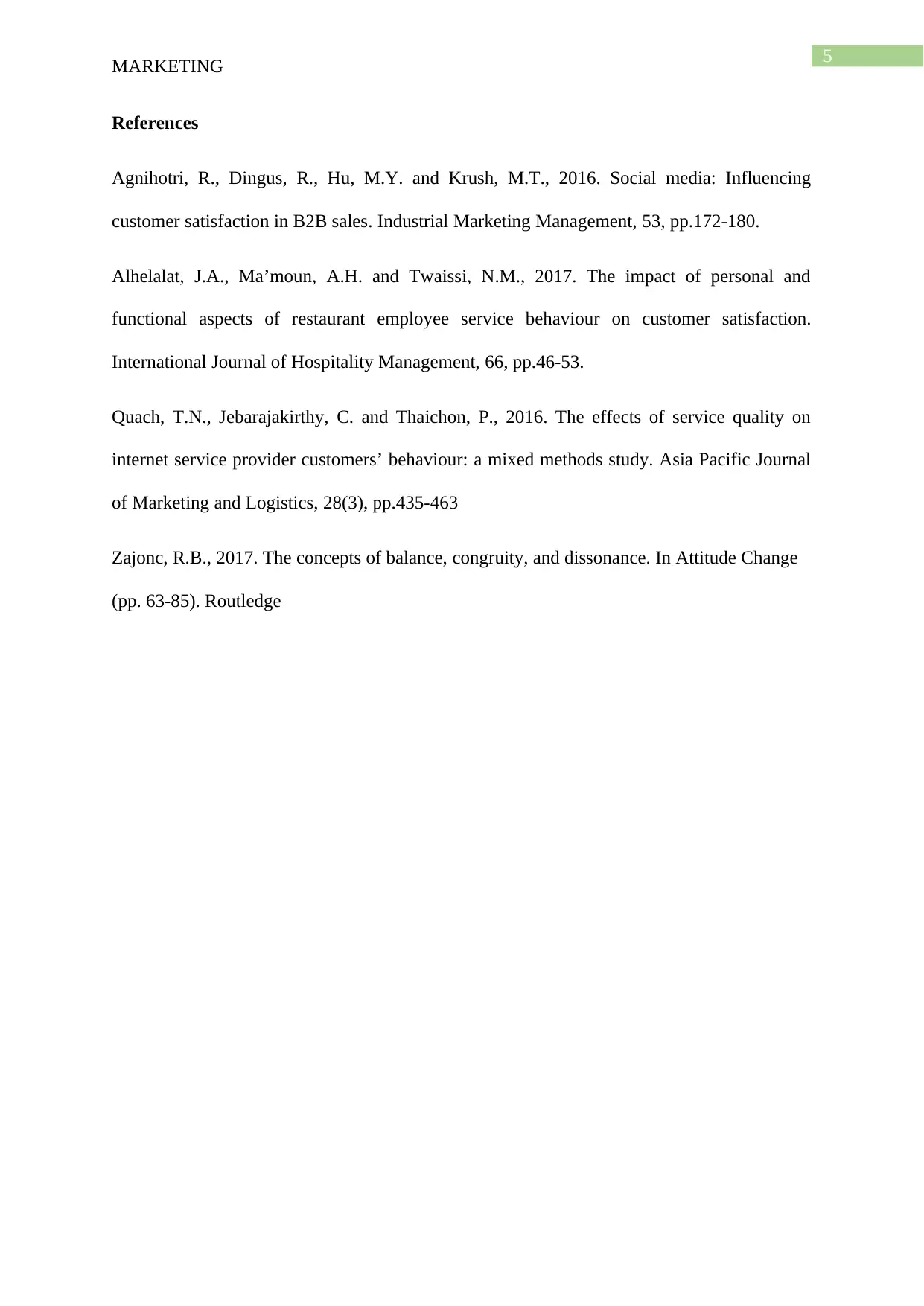
5
MARKETING
References
Agnihotri, R., Dingus, R., Hu, M.Y. and Krush, M.T., 2016. Social media: Influencing
customer satisfaction in B2B sales. Industrial Marketing Management, 53, pp.172-180.
Alhelalat, J.A., Ma’moun, A.H. and Twaissi, N.M., 2017. The impact of personal and
functional aspects of restaurant employee service behaviour on customer satisfaction.
International Journal of Hospitality Management, 66, pp.46-53.
Quach, T.N., Jebarajakirthy, C. and Thaichon, P., 2016. The effects of service quality on
internet service provider customers’ behaviour: a mixed methods study. Asia Pacific Journal
of Marketing and Logistics, 28(3), pp.435-463
Zajonc, R.B., 2017. The concepts of balance, congruity, and dissonance. In Attitude Change
(pp. 63-85). Routledge
MARKETING
References
Agnihotri, R., Dingus, R., Hu, M.Y. and Krush, M.T., 2016. Social media: Influencing
customer satisfaction in B2B sales. Industrial Marketing Management, 53, pp.172-180.
Alhelalat, J.A., Ma’moun, A.H. and Twaissi, N.M., 2017. The impact of personal and
functional aspects of restaurant employee service behaviour on customer satisfaction.
International Journal of Hospitality Management, 66, pp.46-53.
Quach, T.N., Jebarajakirthy, C. and Thaichon, P., 2016. The effects of service quality on
internet service provider customers’ behaviour: a mixed methods study. Asia Pacific Journal
of Marketing and Logistics, 28(3), pp.435-463
Zajonc, R.B., 2017. The concepts of balance, congruity, and dissonance. In Attitude Change
(pp. 63-85). Routledge
⊘ This is a preview!⊘
Do you want full access?
Subscribe today to unlock all pages.

Trusted by 1+ million students worldwide
1 out of 6
Your All-in-One AI-Powered Toolkit for Academic Success.
+13062052269
info@desklib.com
Available 24*7 on WhatsApp / Email
![[object Object]](/_next/static/media/star-bottom.7253800d.svg)
Unlock your academic potential
Copyright © 2020–2025 A2Z Services. All Rights Reserved. Developed and managed by ZUCOL.

